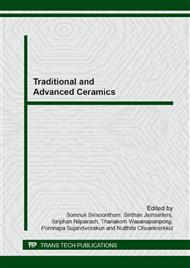[1]
D. Khale and R. Chaudhary, Mechanism of geopolymerization and factors influencing its development: a review, J. Mater. Sci. 42 (2007) 729-746.
DOI: 10.1007/s10853-006-0401-4
Google Scholar
[2]
R.A. Fletcher, K.J.D. MacKenzie, and C.L. Nicholson, The composition range of aluminosilicate geopolymers, J. Eur. Ceram. Soc. 25 (2005) 1471-1477.
Google Scholar
[3]
A. Buchwald, H.D. Zellmann, and Ch. Kaps, Condensation of aluminosilicate gels-model system for geopolymer binders, J. Non-Cryst. Solids. 357 (2011) 1376-1382.
DOI: 10.1016/j.jnoncrysol.2010.12.036
Google Scholar
[4]
P. Duxson, J.L. Provis, G.C. Lukey, S.W. Mallicoat, W.M. Kriven, and J.S.J. Deventer, Understanding the relationship between geopolymer composition, microstructure and mechanical properties, Colloids and Surfaces A: Physicochem. Eng. Aspects. 269 (2005).
DOI: 10.1016/j.colsurfa.2005.06.060
Google Scholar
[5]
K.J.D. MacKenzie, D.R.M. Brew, R.A. Fletcher and R. Vagana, Formation of aluminosilicate geopolymers from 1: 1 layer-lattice minerals pre-treated by various methods: a comparative study, J. Mater. Sci. 42 (2007) 4667-4674.
DOI: 10.1007/s10853-006-0173-x
Google Scholar
[6]
K.J.D. MacKenzie, S. Komphanchi and R. Vagana., Formation of inorganic polymers (geopolymers) from 2: 1 layer lattice aluminosilicates, J. Eur. Ceram. Soc. 28 (2008) 177-181.
DOI: 10.1016/j.jeurceramsoc.2007.06.004
Google Scholar
[7]
V.F.F. Barbosa, K.J.D. MacKenzie, and C. Thaumaturgo, Synthesis and characterization of materials based on inorganic polymers of alumina and silica: sodium polysialate polymers, Int. J. Inorg. Mater. 2 (2000) 309-317.
DOI: 10.1016/s1466-6049(00)00041-6
Google Scholar
[8]
K.Y. Chiang, P.H. Chou, C.R. Hua, K.L. Chien, and C. Cheeseman, Lightweight bricks manufactured from water treatment sludge and rice husks, J. Hazard. Mater. 171 (2009) 76-82.
DOI: 10.1016/j.jhazmat.2009.05.144
Google Scholar
[9]
N.H. Rodriguez, S.M. Ramirez, M.T.B. Varela, M. Guillem, and J. Puig, Re-use of drinking water treatment plant (DWTP) sludge: Characterization and technological behavior of cement mortars with atomized sludge additions, Cem. Concr. Res. 40 (2010).
DOI: 10.1016/j.cemconres.2009.11.012
Google Scholar
[10]
P. Duxson, S.W. Mallicoat, G.C. Lukey, W.M. Kriven, and J.S.J. van Deventer, The effect of alkali and Si/Al ratio on the development of mechanical properties of metakaolin-based geopolymers, Colloids Surf., A. 292 (2007) 8-20.
DOI: 10.1016/j.colsurfa.2006.05.044
Google Scholar
[11]
S.A. Bernal, J.L. Provis, V. Rose, and R.M. de Gutierrez., Evolution of binder structure in sodium silicate-activated slag- metakaolin blends, Cem. Concr. Compos. 33 (2011) 46-54.
DOI: 10.1016/j.cemconcomp.2010.09.004
Google Scholar
[12]
ASTM C39, Standard test Method for Compressive Strength of Cylindrical Concrete Specimens, (2005).
Google Scholar
[13]
W.K.W. Lee, J.S.J. van Deventer, The interface between natural siliceous aggregates and geopolymers, Cem. Concr. Res. 34 (2004) 195-206.
DOI: 10.1016/s0008-8846(03)00250-3
Google Scholar


